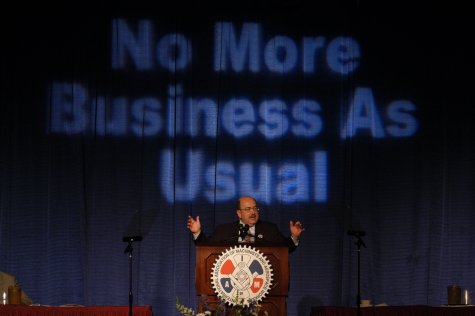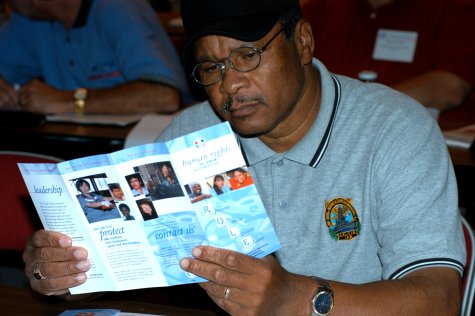|
|
“We are going to do more with less. We will have fewer districts, fewer lodges, fewer officers, fewer staff and fewer programs. But even so, we are going to grow this union,” declared International President Tom Buffenbarger. “From this day forward, there will be no more ‘business as usual’ at this union. “With 90,000 of our brothers and sisters out of work, we’re not going to put up for one moment with anyone who won’t give our dues-paying members the devoted service they deserve. There’s no room here for sly slackers or porkchoppers or for people who are not fully committed to the work of our great union,” declared Buffenbarger.
The conference
agenda focused on several critical areas: streamlining the IAM’s cost
structure; creating a more diverse union; organizing 22,000 new members
per year; doubling the value of IAM contracts; fighting corporate greed
and supporting political candidates who fight for working men and women. In his last address before retiring, General Secretary-Treasurer Don Wharton outlined the steps the IAM is taking to find firm financial footing. “There is bad news,” Wharton said, “but we have taken dramatic steps to reduce expenses and ensured that we will continue to provide excellent service to our members.” IAM membership peaked in 1999 at about 535,000 active members, the same year the Federal Reserve started to raise interest rates and slow the economy. Membership numbers decreased in 2000 and 2001. With the tragic attacks of 9/11 and a lingering recession, active membership plunged to about 430,000 by 2002. The IAM instituted an improved budget process for all IAM departments and territories; instituted a salary freeze for 2004; reduced the frequency or combined conferences; reduced purchases and travel expenses and operated with less staff.
Wharton then
outlined what the IAM needs to do to survive. “We have to continue to
control expenses wherever we can. Then we must find new ways to organize
and grow. IAM General Counsel Allison Beck outlined the emotional and monetary price of workplace bigotry and the steps the IAM is taking to prevent it. “Real solidarity must transcend our differences; differences of gender, race, ethnicity, religion and sexual preference,” said Beck. “We have a legal obligation to ensure that our union is fair and free from discrimination and we have a legal obligation to assist our members with these issues at work.” “We must practice what we preach,” said Buffenbarger. “If we demand fairness in the workplace for our members, then we must demand fairness in our own workplaces and in all our union functions.” Buffenbarger stressed that all local and district lodges will have a Human Rights Committee. “From this moment forward, there is no defense in the IAM for discrimination, harassment or unequal treatment,” he said.
Growing the Union
Mart outlined the
strategies the Eastern Territory has used to win an 85 percent success
rate in representation elections. Canadian GVP Dave Ritchie outlined the common approach for the U.S. and Canada for organizing. “It’s the hardest job in this union, but we have to do it if we are going to maintain our position as a progressive, cutting-edge union,” he said. “We’ve struggled through some difficult times, but our day is coming back. I want to get back to the good days, the days of growth, but we need everyone in this union to commit to organizing to get there.”
Doubling the
Value of an IAM Contract 2004 will be a busy year for negotiations. “2004 will be one of the busiest bargaining years in our history,” said Strategic Resources Director Steve Sleigh. “Contracts covering 28 percent of our membership, about 140,000 members, will be up for negotiation.” Meeting that bargaining challenge calls for new approaches. Jim Beno, Directing Business Rep. For District 190 in Oakland, CA, described the challenges of administering hundreds of contracts that have an average of 15 members per agreement. “Our multi-employer health and welfare plan and pension plan are keys to maintaining the value of our smaller contracts and attracting new members for organizing,” said Beno. Robert Martinez, Directing Business Manager for Local 933 in Tucson, AZ spoke about ways to improve the quality of healthcare that IAM members receive as a key element in controlling rising costs. District 142 General Chairperson Dora Cervantes described the planning and strategy involved in winning a leading contract at Southwest Airlines in just six weeks of negotiations, a process that normally takes years in the airline industry. District 141 President Randy Canale explained the problems of protecting IAM members’ jobs during negotiations with airlines such as Hawaiian, US Airways and United as they struggled to emerge from bankruptcy. District 19 President Robert Reynolds described the heartbreak of protecting IAM members when their company suddenly announces they are shutting the plant a liquidating the business. “IAM negotiators are facing situations they never thought they would face,” said General Vice President Robert Roach, Jr. “When we succeed it’s because we communicated with our members, educated them about the issues and were committed to teamwork.”
A New Day
|

